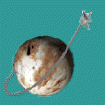
Current Issues:
SpaceViews
SpaceViews Update
Breaking News
Back Issues
Search
Subscriptions
Submissions
Forum
Space Sites of the Week
Home
The Discovery of Hale-Bopp
Despite being several hundred kilometers apart, two astronomers shared the same eureka moment at nearly the same time one July evening in 1995.
Working at his observatory in Cloudcroft, New Mexico, astronomer Alan Hale had turned to the globular cluster M70 to pass the time while waiting for the object he wanted to look at -- another, previously discovered comet -- to rise.
To the southwest, at a dark-sky site south of Phoenix, Thomas Bopp was looking through the eyepiece of a homemade Dobsonian , watching the same globular cluster move out of the field, while several friends planned their next observations.
At around midnight Mountain Time on the night of July 22 (11pm in Arizona, which does not observe daylight savings time), both saw a new fuzzy object appear where no such object should have been visible.
According to Hale, "I immediately noticed a fuzzy object in the field that hadn't been there when I had looked at M70 two weeks earlier." He checked to make sure he was looking in the right part of the sky, then checked other catalogs and a comet identification program, in the event this was a previously-discovered comet.
Hale, a professional astronomer who heads the Southwest institute for Space Research, took advantage of his well-equipped observatory and sent e-mail to the Central Bureau for Astronomical Telegrams, located at the Harvard-Smithsonian Center for Astrophysics in Cambridge, Massachusetts.
Hale sent a second message after he confirmed that the comet was moving against the background stars, and followed the comet until it set in the southwest three hours later.
At the same time Hale noticed the mysterious object near M70, Bopp was looking through the eyepiece of a the 17.5-inch Dobsonian as M70 rotated out of view. While his observing companions chose their next object, Bopp continued to peer through the scope... and saw a new fuzzy object come into view.
Bopp, who was working as a shift supervisor in a construction materials company, called his friends over. They looked at the comet for the next hour through the Dobsonian, watching it move against the background stars. They concluded they had observed a comet.
Bopp returned home that night and sent a telegraph to Cambridge with details of his observations. Since Hale's and Bopp's observations took place at about the same time (only later would it be clear that they had probably come across the comet within a few minutes of each other, though) both were awarded discovery of the comet, and hence its name, Hale-Bopp.
